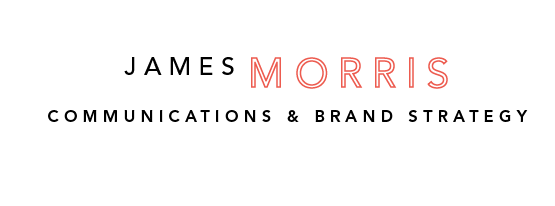
Communicating is an innately human activity. But while everyone has some level of communication skill, putting it to work on behalf of a company is often a different matter. Communications strategy is a set of ideas that help businesses to connect with key audiences. These articles address what I have found to be critical factors in driving better business through better communications.

Communications 101
PRINTABLE PDF
Business can always be made better through better communications.
The concept builds on the notion that whatever business you are in, success will be defined by other people seeing the value in what you do. And while some values are intrinsic, most are better recognized when they are positioned, explained or made clear.
All communications are built on the same equation, regardless of scale or circumstances. Effective business connections start with an understanding of this fact. The elements of the equation are intent, interest and the gap that separates the two. The function of communicating is to fill the gap between the initiator of a conversation and the people to whom he
or she wishes to connect.
Intent
If you’ve ever had to figure out why someone was talking to you, you’ll understand the importance of this factor. It is socially uncomfortable to be drawn into a conversation with no context or understanding of why. The natural reaction
is to try to exit as quickly as possible. People who talk to you without permission or clarity of intent quickly become social pariahs.
The first job in communicating effectively is to share your intent with the other person.
Interest
On the other hand, you’ve probably wanted to leave plenty of conversations where you’ve had full understanding of the other guy’s intent. Why? Because you weren’t interested.
We all have a pre-existing set of interests that define us as individuals. Those interests mark the parameters of likelihood that I’ll be interested in what you have to say. The trick is to discover, as quickly and efficiently as possible, our shared interests.
The commonality between your intent and my interests will determine whether a meaningful conversation will happen.
The gap
Bridging the gap between your intent and my interests is a matter of shared culture. This agreement is the stuff of sales, commitment, action or whatever you may have been out to achieve.
It’s important to remember that the difference between a transactional exchange and an ongoing relationship generally comes down to how good the other guy felt about putting his money on the table. The quality of your product or service is only part of the lasting experience. The bigger part is sociological in nature and demands more of you than a promise and a price.

On Brand
So many people mean so many different things by the term “brand” that it pays to establish your definition at the start of the discussion – for the sake of clarity.
For my purposes as a communications strategist, “brand” is what’s known about you on the basis of your name alone. It’s an effective definition in that it boasts simplicity and allows for a host of considerations that make the subject of branding actually quite broad.
At its heart, brand is a sociological consideration. It lives in the feelings of everyone who comes into contact with your product, service or organization. It is the shared experience of all of those people, individually and in groups.
Marketing and branding are closely related but not the same thing. Marketing is about external buy-in only. Brand includes internal considerations. Think of it this way: marketing will inform the purchasing public as to what you are selling, how much it costs and why it is a better deal than competing products in the marketplace. Branding includes every business factor that came into getting your product to the shelf, as well as the contexts through which it is being sold.
News stories, for instance, about abusive manufacturing circumstances have had negative impact on such world brands as Apple and Nike. Starbucks makes its standards for coffee purchasing a key part of its corporate messaging because its customers care about the ethics of their sourcing.
But creating a brand starts with much more basic considerations. The core of every successful brand is a simply expressed promise that addresses a basic human truth. Coke, for instance, understands that they can sell a lot of product on the promise of happiness. Its a good promise, partly because literally everyone in the world can relate to it, and more importantly because it's a promise they can deliver on. For people who like Coke, Coke creates happiness.
The first question in the development of a brand strategy is therefore “what does the thing you are selling actually mean to the people you would like to have buy it?”
Figuring that out means understanding yourself as much as it means understanding your audience. The insight that drives brand communications is often as important as product quality. Building on that insight, the challenge is to keep the message fresh and relevant while also maintaining the qualities that make you who you are.
Remember that other people’s opportunity to have an opinion about you is not limited to direct experience. At a certain point, what people say to each other about you will outweigh whatever you may have to say about yourself – and those people constantly measure your performance against your promise.
Brand-consciousness helps companies to stay on target – over time and regardless of scope.
PRINTABLE PDF
On Corporate Reporting

Your Web Site
If there is a single rule to guide the effective development of a commercial Web site, it is not to let functional opportunity be the leading consideration. You have to remember that simply being able to do something is never a good enough reason for doing it. It’s that old “if everybody else jumped off a bridge” logic.
Since the dawn of commercial Web sites, there has been a steady succession of trends that have either done well or badly for their implementors, depending on a host of factors. Remember animated logos, Flash intros, landing pages, slide shows and the like? They each took over the Web in their day, but did not necessarily do much to drive business – which should have been the goal.
What does work on the Web is anything that enables choice and provides satisfaction.
Web sites are inherently passive in that they present themselves for the consideration of visitors who then choose whether to click or not. At their most effective they invite consideration (through design and content) and encourage navigation (which is the interactive part.) When the visitor starts navigating your site, he or she is making choices that are driven by curiosity and expectation. Your site should be structured to meet curiosity with information and expectation with experience. All of which requires a content structure that anticipates the interests of the people whose attention you hope to capture.
The trick to doing it right is to remember that, having lived with rapidly transitioning technology for going on 20 years now, the medium is not the message. The message is the message. And the sole purpose of any commercial Web site is to get the message to as broad an audience as possible in a manner that inspires responses that will help your business to thrive.
What does this mean? You can render your site immune to distracting trends by building it on the basis of a solid strategy. One that matches your business intent with the interests of the targeted audience. For instance, if the 6 most important pieces of information about your company are written in stone, you probably don’t need the ability to personally update your home page on an ongoing basis. In fact, updatability on the Web is only a factor when you are comfortable with producing and distributing new content on a regular basis. If your clients tend to look for key information from within predictable categories, you may want to use those categories as your primary navigational structure.
Working with clients, I tend not to talk about the site as a thing unto itself, but rather as a tool for creating information flow and relationships.
PRINTABLE PDF

Creating Custom Content
What is Content?
“Content” is the DNA of effective communications. It is the ongoing message that you deliver to the groups of people whose good opinion of your name will drive business in the information age.
The traditional model for reaching customers has had the rug pulled out from under it with the advent of new communications channels – the relationship between companies and their clients now includes expectations of interactivity and meaningful connection.
Customers can be identified individually, on a broad scale. And they will identify themselves to businesses through their interests. But that creates a test of your relevance that's driven by their self-interest. The relationship favours their ability to listen or block you out. If what you do lines up with what they like, they’ll be open to you. And that creates a need for companies to be interesting to their customers – on an ongoing basis.
While advertising shouts a message, content delivery provides meaningful information. While advertising interrupts experiences, well-packaged content provides an experience in itself.
What content is and how it is delivered depends on how a company wants to be understood by its client base. That means knowing the interests and habits of the people to whom those companies wish to appeal. It could mean creating that connection through a well-written electronic newsletter, a quarterly magazine, an email blast, a smartphone app or any of a variety of devices. The goal is to maintain contact with and provide value for those on the receiving end.
It pays to remember that, in any context, people appreciate those who demonstrate an active understanding of their interests. It’s a hallmark of human interaction and it’s the cornerstone of an effective communications strategy.
PRINTABLE PDF

The Golden Rules of Naming
If “Brand” is what’s known about you on the basis of your name alone, then your name is a pretty important consideration in branding. It is you, in a nutshell.
And while a rose by any other name would smell so sweet, the word is an excellent reminder of the experience. Because Juliet so famously asked, “What’s in a name?” hers has become an instant reference point for the tragedy of forbidden love – just check with anyone named Juliet. But naming isn’t all roses and Shakespeare.
Here is what I think of as the 3 Golden Rules of Naming.
Look back from the future.
Names develop resonance with experience. Think of a baby. On the day the kid enters the world, no baby brings more than a generic “babyness” to his or her given name. There is a new Bobby or Sue in the world, but the story is more about the parents’ achievement than anything else. Flash-forward 17 years and you can bet you’ll have a whole lot of context for understanding who that baby has become.
Businesses shouldn’t fall into the trap of naming their babies. They should name their future teenagers and adults. This is a difficult challenge for most people, but if you can mentally transport yourself into a future that includes years of experience, what might seem like a great name now can lose its lustre. Similarly, a name that seems foreign or outside of your expectations may actually have the potential to feel perfect later–and even to change the way you think about your own company.
Allow for context.
If an international gold mining company was called “International Gold Miners,” the name would convey very little about their managerial expertise or corporate approach. It would describe their function, but what else? Is it
a good name? That would depend on what they wanted to communicate through its use.
Business owners should remember that the sign on the lawn will always have a building behind it. The business card is handed personally or enclosed with a letter. The name will be typeset, designed into a logo and printed on carefully chosen materials that include images and messages that tell a story. Because corporate names are rarely seen outside
of a greater context, the name itself will always have help. It is important to remember that the name of a company does not have to convey everything.
You are not the target.
Naming is subjective. But the most important thing to remember is that the people who choose the name are already on board. The name doesn’t have to sell them anything. Outside of their culture, at the other end of their marketing efforts, there’s a whole category of people whose opinions will matter more.
“I don’t like it” is never a good enough reason to shoot down a suggestion. Instead, the real question should be: "What will others think?"
Have fun. Seriously.
The 4th of the 3 Golden rules is a matter of process and context. You simply cannot be creative or explore the fullest range of potential from a negative point of view. To get at the best results, you have to have fun. Good naming processes always include laughter.
PRINTABLE PDF








